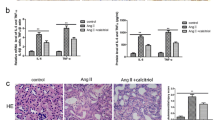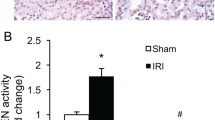Abstract
Chronic kidney disease (CKD) increases myocardial infarct size by an unknown mechanism. Here we examined the hypothesis that impairment of protective PI3K-PDK1-Akt and/or mTORC-Akt signaling upon reperfusion contributes to CKD-induced enlargement of infarct size. CKD was induced in rats by 5/6 nephrectomy (SNx group) 4 weeks before myocardial infarction experiments, and sham-operated rats served as controls (Sham group). Infarct size as a percentage of area at risk after ischemia/reperfusion was significantly larger in the SNx group than in the Sham group (56.3 ± 4.6 vs. 41.4 ± 2.0%). In SNx group, myocardial p-Akt-Thr308 level at baseline was elevated, and reperfusion-induced phosphorylation of p-Akt-Ser473, p-p70s6K and p-GSK-3β was significantly suppressed. Inhibition of Akt-Ser473 phosphorylation upon reperfusion by Ku-0063794 significantly increased infarct size in the Sham group but not in the SNx group. There was no difference between the two groups in activities of mTORC2 and PDK1 and protein level of PTEN. However, the PP2A regulatory subunit B55α, which specifically targets Akt-Thr308, was reduced by 24% in the SNx group. Knockdown of B55α by siRNA increased baseline p-Akt-Thr308 and blunted Akt-Ser473 phosphorylation in response to insulin-like growth factor-1 (IGF-1) in H9c2 cells. A blunted response of Akt-Ser473 to IGF-1 was also observed in HEK293 cells transfected with a p-Thr308-mimetic Akt mutant (T308D). These results indicate that increased Akt-Thr308 phosphorylation by down-regulation of B55α inhibits Akt-Ser473 phosphorylation upon reperfusion in CKD and that the impaired Akt activation by insufficient Ser473 phosphorylation upon reperfusion contributes to infarct size enlargement by CKD.





Similar content being viewed by others
References
Ananthanarayanan B, Fosbrink M, Rahdar M, Zhang J (2007) Live-cell molecular analysis of Akt activation reveals roles for activation loop phosphorylation. J Biol Chem 282:36634–36641. doi:10.1074/jbc.M706227200
Betz C, Stracka D, Prescianotto-Baschong C, Frieden M, Demaurex N, Hall MN (2013) mTOR complex 2-Akt signaling at mitochondria-associated endoplasmic reticulum membranes (MAM) regulates mitochondrial physiology. Proc Natl Acad Sci USA 10:12526–12534. doi:10.1073/pnas.1302455110
Bongartz LG, Joles JA, Verhaar MC, Cramer MJ, Goldschmeding R, Tilburgs C, Gaillard CA, Doevendans PA, Braam B (2012) Subtotal nephrectomy plus coronary ligation leads to more pronounced damage in both organs than either nephrectomy or coronary ligation. Am J Physiol Heart Circ Physiol 302:H845–H854
Boulbés DR, Shaiken T, dos Sarbassov D (2011) Endoplasmic reticulum is a main localization site of mTORC2. Biochem Biophys Res Commun 413:46–52. doi:10.1016/j.bbrc.2011.08.034
Byrne CJ, McCafferty K, Kieswich J, Harwood S, Andrikopoulos P, Raftery M, Thiemermann C, Yaqoob MM (2012) Ischemic conditioning protects the uremic heart in a rodent model of myocardial infarction. Circulation 125:1256–1265. doi:10.1161/CIRCULATIONAHA.111.055392
Chitalia VC, Shivanna S, Martorell J, Balcells M, Bosch I, Kolandaivelu K, Edelman ER (2013) Uremic serum and solutes increase post-vascular interventional thrombotic risk through altered stability of smooth muscle cell tissue factor. Circulation 127:365–376. doi:10.1161/CIRCULATIONAHA
Clark LE, Khan I (2010) Outcomes in CKD: what we know and what we need to know. Nephron Clin Pract 114:c95–c102. doi:10.1159/000254381
Dikow R, Kihm LP, Zeier M, Kapitza J, Törnig J, Amann K, Tiefenbacher C, Ritz E (2004) Increased infarct size in uremic rats: reduced ischemia tolerance? J Am Soc Nephrol 15:1530–1536. doi:10.1097/01.ASN.0000130154.42061.C6
Dikow R, Wasserhess C, Zimmerer K, Kihm LP, Schaier M, Schwenger V, Hardt S, Tiefenbacher C, Katus H, Zeier M, Gross LM (2009) Effect of insulin and glucose infusion on myocardial infarction size in uraemic rats. Basic Res Cardiol 104:571–579. doi:10.1007/s00395-009-0018-2
Di Lullo L, House A, Gorini A, Santoboni A, Russo D, Ronco C (2015) Chronic kidney disease and cardiovascular complications. Heart Fail Rev 20:259–272. doi:10.1007/s10741-014-9460-9
Ebner M, Sinkovics B, Szczygieł M, Ribeiro DW, Yudushkin I (2017) Localization of mTORC2 activity inside cells. J Cell Biol 216:343–353. doi:10.1083/jcb.201610060
Francis J, Weiss RM, Wei SG, Johnson AK, Felder RB (2001) Progression of heart failure after myocardial infarction in the rat. Am J Physiol Regul Integr Comp Physiol 281:R1734–R1745
Garibotto G, Bonanni A, Verzola D (2012) Effect of kidney failure and hemodialysis on protein and amino acid metabolism. Curr Opin Clin Nutr Metab Care 15:78–84. doi:10.1097/MCO.0b013e32834d9df6
Griffiths EJ, Halestrap AP (1995) Mitochondrial non-specific pores remain closed during cardiac ischaemia, but open upon reperfusion. Biochem J 307:93–98. doi:10.1042/bj3070093
Heusch G (2015) Molecular basis of cardioprotection: signal transduction in ischemic pre-, post-, and remote conditioning. Circ Res 116:674–699. doi:10.1161/CIRCRESAHA.116.305348
Hotta H, Miura T, Miki T, Togashi N, Maeda T, Kim SJ, Tanno M, Yano T, Kuno A, Itoh T, Satoh T, Terashima Y, Ishikawa S, Shimamoto K (2010) Angiotensin II type 1 receptor-mediated upregulation of calcineurin activity underlies impairment of cardioprotective signaling in diabetic hearts. Circ Res 106:129–132. doi:10.1161/CIRCRESAHA.109.205385
Juhaszova M, Zorov DB, Kim SH, Pepe S, Fu Q, Fishbein KW, Ziman BD, Wang S, Ytrehus K, Antos CL, Olson EN, Sollott SJ (2004) Glycogen synthase kinase-3β mediates convergence of protection signaling to inhibit the mitochondrial permeability transition pore. J Clin Invest 113:1535–1549. doi:10.1172/JCI19906
Koppe L, Pelletier CC, Alix PM, Kalbacher E, Fouque D, Soulage CO, Guebre-Egziabher F (2014) Insulin resistance in chronic kidney disease: new lessons from experimental models. Nephrol Dial Transplant 29:1666–1674. doi:10.1093/ndt/gft435
Kuo YC, Huang KY, Yang CH, Yang YS, Lee WY, Chiang CW (2008) Regulation of phosphorylation of Thr-308 of Akt, cell proliferation, and survival by the B55alpha regulatory subunit targeting of the protein phosphatase 2A holoenzyme to Akt. J Biol Chem 283:1882–1892. doi:10.1074/jbc.M709585200
Langston RD, Presley R, Flanders WD, McClellan WM (2003) Renal insufficiency and anemia are independent risk factors for death among patients with acute myocardial infarction. Kidney Int 64:1398–1405. doi:10.1046/j.1523-1755.2003.00200.x
Miki T, Miura T, Hotta H, Tanno M, Yano T, Sato T, Terashima Y, Takada A, Ishikawa S, Shimamoto K (2009) Endoplasmic reticulum stress in diabetic hearts abolishes erythropoietin-induced myocardial protection by impairment of phospho-glycogen synthase kinase-3beta-mediated suppression of mitochondrial permeability transition. Diabetes 58:2863–2872. doi:10.2337/db09-0158
Miki T, Miura T, Yano T, Takahashi A, Sakamoto J, Tanno M, Kobayashi H, Ikeda Y, Nishihara M, Naitoh K, Ohori K, Shimamoto K (2006) Alteration in erythropoietin-induced cardioprotective signaling by postinfarct ventricular remodeling. J Pharmacol Exp Ther 317:68–75. doi:10.1124/jpet.105.095745
Miura T, Tanno M (2012) The mPTP and its regulatory proteins: final common targets of signalling pathways for protection against necrosis. Cardiovasc Res 94:181–189. doi:10.1093/cvr/cvr302
Murphy E, Steenbergen C (2008) Does inhibition of glycogen synthase kinase protect in mice? Circ Res 103:226–228. doi:10.1161/CIRCRESAHA.108.181602
Nishihara M, Miura T, Miki T, Sakamoto J, Tanno M, Kobayashi H, Ikeda Y, Ohori K, Takahashi A, Shimamoto K (2006) Erythropoietin affords additional cardioprotection to preconditioned hearts by enhanced phosphorylation of glycogen synthase kinase-3 beta. Am J Physiol Heart Circ Physiol 291:H748–H755. doi:10.1152/ajpheart.00837.2005
Nishizawa K, Yano T, Tanno M, Miki T, Kuno A, Tobisawa T, Ogasawara M, Muratsubaki S, Ohno K, Ishikawa S, Miura T (2016) Chronic treatment with an erythropoietin receptor ligand prevents chronic kidney disease-induced enlargement of myocardial infarct size. Hypertension 68:697–706. doi:10.1161/HYPERTENSIONAHA.116.07480
Ohori K, Miura T, Tanno M, Miki T, Sato T, Ishikawa S, Horio Y, Shimamoto K (2008) Ser9 phosphorylation of mitochondrial GSK-3beta is a primary mechanism of cardiomyocyte protection by erythropoietin against oxidant-induced apoptosis. Am J Physiol Heart Circ Physiol 295:H2079–H2086. doi:10.1152/ajpheart.00092.2008
Risso G, Blaustein M, Pozzi B, Mammi P, Srebrow A (2015) Akt/PKB: one kinase, many modifications. Biochem J 468:203–214. doi:10.1042/BJ20150041
Rodrigues FB, Bruetto RG, Torres US, Otaviano AP, Zanetta DM, Burdmann EA (2010) Effect of kidney disease on acute coronary syndrome. Clin J Am Soc Nephrol 5:1530–1536. doi:10.2215/CJN.01260210
Ryu ES, Kim MJ, Shin HS, Jang YH, Choi HS, Jo I, Johnson RJ, Kang DH (2013) Uric acid-induced phenotypic transition of renal tubular cells as a novel mechanism of chronic kidney disease. Am J Physiol Renal Physiol 304:F471–F480. doi:10.1152/ajprenal.00560
Sciarretta S, Volpe M, Sadoshima J (2014) Mammalian target of rapamycin signaling in cardiac physiology and disease. Circ Res 114:549–564. doi:10.1161/CIRCRESAHA.114.302022
Semple DJ, Bhandari S, Seymour AM (2012) Uremic cardiomyopathy is characterized by loss of the cardioprotective effects of insulin. Am J Physiol Renal Physiol 303:F1275–F1286. doi:10.1152/ajprenal.00048.2012
Semple D, Smith K, Bhandari S, Seymour AM (2011) Uremic cardiomyopathy and insulin resistance: a critical role for akt? J Am Soc Nephrol 22:207–215. doi:10.1681/ASN.2009090900
Skyschally A, van Caster P, Boengler K, Gres P, Musiolik J, Schilawa D, Schulz R, Heusch G (2009) Ischemic postconditioning in pigs: no causal role for RISK activation. Circ Res 104:15–18. doi:10.1161/CIRCRESAHA.108.186429
Song Y, Yu Q, Zhang J, Huang W, Liu Y, Pei H, Liu J, Sun L, Yang L, Li C, Li Y, Zhang F, Qu Y, Tao L (2014) Increased myocardial ischemia-reperfusion injury in renal failure involves cardiac adiponectin signal deficiency. Am J Physiol Endocrinol Metab 306:E1055–E1064. doi:10.1152/ajpendo.00428.2013
Taylor D, Bhandari S, Seymour AM (2015) Mitochondrial dysfunction in uremic cardiomyopathy. Am J Physiol Renal Physiol 308:F579–F587. doi:10.1152/ajprenal.00442.2014
Virzì GM, Clementi A, Ronco C (2016) Cellular apoptosis in the cardiorenal axis. Heart Fail Rev 21:177–189. doi:10.1007/s10741-016-9534-y
Wright RS, Reeder GS, Herzog CA, Albright RC, Williams BA, Dvorak DL, Miller WL, Murphy JG, Kopecky SL, Jaffe AS (2002) Acute myocardial infarction and renal dysfunction: a high-risk combination. Ann Intern Med 37:563–570. doi:10.7326/0003-4819-137-7-200210010-00
Yano T, Ferlito M, Aponte A, Kuno A, Miura T, Murphy E, Steenbergen C (2014) Pivotal role of mTORC2 and involvement of ribosomal protein S6 in cardioprotective signaling. Circ Res 114:1268–1280. doi:10.1161/CIRCRESAHA.114.303562
Yano T, Miki T, Tanno M, Kuno A, Itoh T, Takada A, Sato T, Kouzu H, Shimamoto K, Miura T (2011) Hypertensive hypertrophied myocardium is vulnerable to infarction and refractory to erythropoietin-induced protection. Hypertension 57:110–115. doi:10.1161/HYPERTENSIONAHA.110.158469
Author information
Authors and Affiliations
Corresponding author
Ethics declarations
Funding
The present study was supported by Grant-in-aid for Scientific Research (#2646113 and #16K09505) from the Japan Society for the Promotion of Science, Tokyo, Japan and by Grant for Research and Education 2015 from Sapporo Medical University, Sapporo, Japan.
Conflict of interest
The authors declare that they have no competing interests.
Electronic supplementary material
Below is the link to the electronic supplementary material.
Rights and permissions
About this article
Cite this article
Tobisawa, T., Yano, T., Tanno, M. et al. Insufficient activation of Akt upon reperfusion because of its novel modification by reduced PP2A-B55α contributes to enlargement of infarct size by chronic kidney disease. Basic Res Cardiol 112, 31 (2017). https://doi.org/10.1007/s00395-017-0621-6
Received:
Accepted:
Published:
DOI: https://doi.org/10.1007/s00395-017-0621-6




